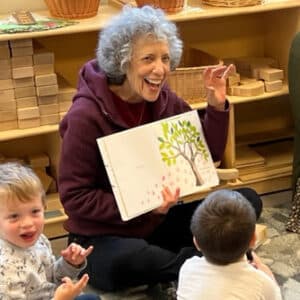
Hours: 10 a.m.–5 p.m. | Fri. & Sat. till 8 p.m.
- Educators
- Field Trips
- Grades 7 to 12
- College and University Programs
- Professional Development
- Get in the Game
- Scouts
- Woodbury School
- Blog
- Journal of Play
- G2
- Visit
- Hours and Admission
- Group Admission
- Directions and Parking
- Events Calendar
- Membership
- Accessibility
- Donation Requests
- Parties and Rentals
- Dine and Shop
- Digital Map
- Exhibits
- Museum Exhibits
- Online Exhibits
- National Toy Hall of Fame
- World Video Game Hall of Fame
- Skyline Climb
- Play Lab
- Butterfly Garden
- Carousel and Train
- Collections
- Search Collections
- Brian Sutton-Smith Library & Archives of Play
- International Center for the History of Electronic Games
- The National Archives of Game Show History
- Research Access
- Research Fellowships
- Donate an Artifact
- Preservation
- Support
- About
Linda Margolin
When Linda Margolin was a child in the 1950s, her parents would take the family on long drives and intentionally get lost, so that they could discover a new route home in a time long before GPS and smartphones. Farblunget, they called it, an old Yiddish word for aimlessly wandering. But to Linda, it wasn’t just wandering. It was an adventure. It was thinking of new possibilities. It was play.

Linda took that concept of farblunget to her other play—spending countless summers at camp or in the woods in Upstate New York (away from the big city where she was born) exploring, being free-spirited, and taking risks. She credits Leonard Bernstein, the American composer and conductor, who led a children’s music series she attended when she was younger, for encouraging her free, creative, imaginative play. Play, according to Linda, should be all about pushing boundaries and expectations, and about stretching one’s mind and perspectives.
That’s why Linda detested school.
The schools she attended in the 1950s, like so many still today, were devoid of play—an endless march of standardized tests and static curriculum, and of classrooms with 30 students working on the same project, being led to draw the same, predictable conclusions. Linda found it profoundly “boring”—about as far from farblunget as it could get.
Linda became a teacher as an act of rebellion against the monotony of school. “I couldn’t allow that to happen to other students,” she says. Linda, who taught elementary school students and later adults for nearly 30 years, says that she was the “far out” teacher, preaching the importance of creativity and imagination. She didn’t care much about the mandated curriculum. She encouraged her students to ask questions and choose how they wanted to learn. She introduced play into her classroom, giving students the opportunity to demonstrate what they had learned through the arts, music, and other creative outlets.
Two years ago, when Linda stepped into The Strong National Museum of Play for the first time, she felt immediately at home. “The minute I walked in, I was taken by the whole concept of play and how valuable it is,” she says. Play, as they say, was all around. Even the architecture of the museum, she noted, had playful whimsy. At The Strong, Linda found commonality—the next opportunity in a life threaded together by play. She describes the museum as “…a place I believe in that supports who I am.”
That’s why Linda became a supporter of the museum and decided to become a member of the Woodbury Society by making The Strong—specifically, the education wing of the museum—a beneficiary of her estate. Linda says that we’re in a bizarre time in education, where there’s little focus on developing creative thinkers and risk-takers. She wants her support to help the next generation of children through play-based professional development opportunities for teachers and other education programs, including the museum’s Woodbury School and Generation Two program (which brings play into area classrooms.)
“Play is a community and creates community, and we need more ways in this world to be brought together,” Linda says. “A place like The Strong offers a variety of possibilities.”
A variety of possibilities? That sounds a lot like farblunget. And a lot like play.
If you want to support the next generation of play through a planned gift, contact Rebecca Steiner at advancement@museumofplay.org


